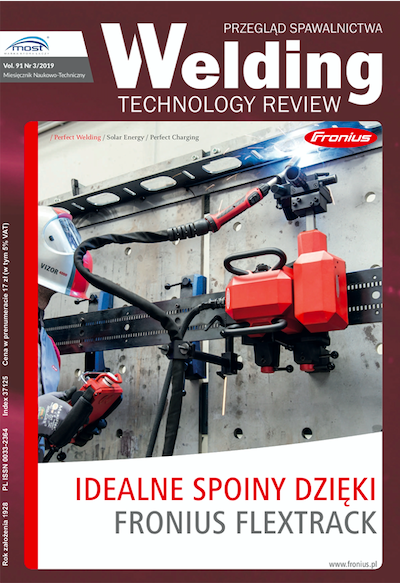Verification of normal distribution of welding distortions
##plugins.themes.bootstrap3.article.main##
Abstrakt
The aim of this paper is to answer the question of the distribution of welding distortions. The MIG method was used to make 31 butt welds of 0H18N9 sheet metal, of 6 mm thickness and dimensions 150x350 mm. All joints are made with constant parameters of the welding process. Statistical analysis of the distribution and Kolomogorov-Smirnov test were used in this paper. On the grounds of the analysis it was proved that the distribution of welding deformations is a normal distribution. This justifies the use of experiment planning methods and the use of average values. The relatively high value of the standard deviation makes it necessary to take into account the geometrical parameters of the joint.
Pobrania
##plugins.themes.bootstrap3.article.details##
Creative Commons CC BY 4.0 https://creativecommons.org/licenses/by/4.0/
Artykuły czasopisma Welding Technology Review (Przegląd Spawalnictwa) publikowane są w otwartym dostępie na licencji CC BY (licencja Creative Commons Uznanie autorstwa 4.0 Międzynarodowe). Licencja CC BY jest najbardziej otwartą dostępną licencją i uważaną za „złoty standard” w formule otwartego dostępu; jest również preferowany przez wielu fundatorów badań. Licencja ta umożliwia czytelnikom kopiowanie i redystrybucję materiału na dowolnym nośniku i w dowolnym formacie, a także zmienianie, przekształcanie lub budowanie na nim materiału, w tym do użytku komercyjnego, pod warunkiem wskazania oryginalnego autora.
Bibliografia
Adamczuk P.C., Machado I.G., Mazzaferro J.A.E., Methodology for predicting the angular distortion in multi-pass butt-jointwelding, Journal of Materials Processing Technology, 2017, Vol. 240, 305313. DOI: https://doi.org/10.1016/j.jmatprotec.2016.10.006
Deng D., Liang W., Murakawa H., Determination of welding deformation in fillet-welded joint by means of numerical simulation and comparison with experimental measurements, Journal of Materials Processing Technology, 2007, Vol. 183, 219225. DOI: https://doi.org/10.1016/j.jmatprotec.2006.10.013
Gannon L., Liu Y., Pegg N., Smith M., Effect of welding sequence on residual stress and distortion in flat-bar stiffened plates, Marine Structures, 2010, Vol. 23, 385404. DOI: https://doi.org/10.1016/j.marstruc.2010.05.002
Guangming F., Marcelo I.L., Menglan D., Segen F.E., Influence of the welding sequence on residual stress and distortion of fillet welded structures, Marine Structures, 2016, Vol. 46, 3055. DOI: https://doi.org/10.1016/j.marstruc.2015.12.001
Tian L., Luo Y., Wang Y., Wu. X., Prediction of transverse and angular distortions of gas tungsten arc bead-on-plate welding using artificial neural network, Materials and Design, 2014, Vol. 54, 458472. DOI: https://doi.org/10.1016/j.matdes.2013.08.082
Liang W., Murakawa H., Predicting Welding Distortion in a Panel Structure with Longitudinal Stiffeners Using Inherent Deformations Obtained by Inverse Analysis Method, Hindawi Publishing Corporation The Scientific World Journal, Vol. 2014, Article ID 601417, 8 pages. DOI: https://doi.org/10.1155/2014/601417
Pałubicki S., Karpiński S., Wpływ energii liniowej na skłonność powstawania pęknięć gorących w procesie spawania stali S355J2WP metodą 135, Welding Technology Review, 2015, Vol. 87(4), 2127. DOI: https://doi.org/10.26628/ps.v87i4.136
Poch K., Plany eksperymentu. Opracowanie planu oceny czułości badań magnetyczno-proszkowych, Welding Technology Review, 2012, Vol. 87 (4), 4148. DOI: https://doi.org/10.26628/ps.v84i2.398
Kukiełka L., Podstawy badań inżynierskich, Wydawnictwo Naukowe PWN, Warszawa 2002.
Urbański T., Węzeł hybrydowy prognozowanie odkształcenia kątowego łącznika na podstawie planowanego eksperymentu trójwartościowego, Welding Technology Review, 2017, Vol. 89(9), 613. DOI: https://doi.org/10.26628/ps.v89i9.805
